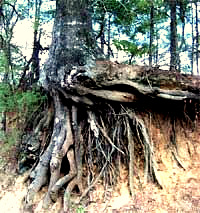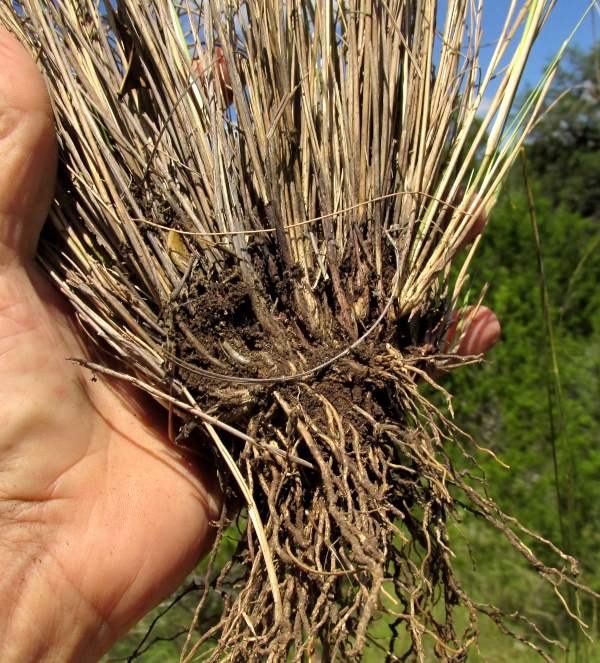
 Cabbage seedling with white, fibrous roots
Cabbage seedling with white, fibrous rootsTypically 75% to 95% of a plant consists of water, though it depends on which plant, what part of the plant, etc. Such a high water content reflects the evolutionary histories of both plants and animals: The ancestors of all us earthly, land-dwelling organisms came from the seas. Our "roots" are in water, and from the beginning we've developed so that we need plenty of it.
ROOTS AREN'T STRAWS
When a typical plant sends down roots, it's not at all like digging a well or poking a finger into dirt. Root advance at their tips. They're not pushed along, but rather the cells at the root's very tip grow toward water. Behind the advancing root tips, roots do grow, but they grow outward, not forward.

Amazingly, it's still not perfectly clear how a root tip "knows" which way to turn in order to grow toward water. Recent studies indicate that something at the molecular level at root tips encourages the tip to grow toward the moister side of the tip. The process of orienting toward areas of higher moisture content is referred to as hydrotropism.
At the left, bark-covered oak-tree roots exposed at a roadcut absorb very little water from the soil. Roots absorb water mostly through slender, somewhat cobwebby hairs at and near their tips, though some enters through bark-covered larger roots.
ROOT HAIRS
 The fuzzy stuff on the much-magnified roots at the right are root hairs. Each root hair is less than 0.04-inch long (1 mm). An interesting feature of root hairs is that each hair is essentially a very long, slender bulge from the side of a single cell embedded in the "skin" of the root it's growing from. It's a cell you can see with your naked eyes. Most cells are so tiny that they're practically invisible.
The fuzzy stuff on the much-magnified roots at the right are root hairs. Each root hair is less than 0.04-inch long (1 mm). An interesting feature of root hairs is that each hair is essentially a very long, slender bulge from the side of a single cell embedded in the "skin" of the root it's growing from. It's a cell you can see with your naked eyes. Most cells are so tiny that they're practically invisible.

A single clumpgrass such as the Purple Three-awn Grass, Aristida purpurea, shown at the left, produces a lot of roots. In a classic study by H.J. Dittmer (American Journal of Botany Vol. 24, No.7, July, 1937), a single rye plant -- a kind of grass -- growing about 20 inches high (50cm) and consisting of a clump of about 80 shoots, was found to have 380 miles of roots (612kms), and this included 14 billion root hairs! If all these root hairs had been split open and spread flat on a floor, their combined surface area would have covered more than 4,000 square feet (370 sq. meters) -- about the floor space occupied by two or three good-sized houses. With such a large root-hair surface-area absorbing water for that single grass plant, no wonder rye can grow in fairly dry soil!
In typical soil, water is available to plants mostly as a thin film surrounding every microscopic soil particle. Root hairs absorb this water when they grow into the soil-particle's vicinity and then, molecule by molecule, water diffuses through the root-hair's cell membrane, flows toward the main roots, and enters a kind of pipeline carrying the water upward to the rest of the plant.